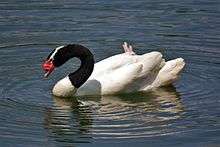Black-necked swan
| Black-necked swan | |
|---|---|
 | |
| Scientific classification | |
| Kingdom: | Animalia |
| Phylum: | Chordata |
| Class: | Aves |
| Order: | Anseriformes |
| Family: | Anatidae |
| Subfamily: | Anserinae |
| Tribe: | Cygnini |
| Genus: | Cygnus |
| Species: | C. melancoryphus |
| Binomial name | |
| Cygnus melancoryphus (Molina, 1782)[2] | |
| Synonyms | |
| |
The black-necked swan (Cygnus melancoryphus) is a swan that is the largest waterfowl native to South America.
Description
Adults average 102 to 124 cm (40 to 49 in) and weigh 3.5-6.7 kg (7.7-14.8 lbs).[3] The wingspan ranges from 135 to 177 cm (53 to 70 in).[4] The body plumage is white with a black neck and head and greyish bill. It has a red knob near the base of the bill and white stripe behind eye. The sexes are similar, with the female slightly smaller. The cygnet has a light grey plumage with black bill and feet. The black-necked swan was formerly placed in monotypic genus, Sthenelides.
The smallest member in its genus, it is found in freshwater marshes, lagoon and lake shores in southern South America. The black-necked swan breeds in Chilean Southern Zone, Patagonia, Tierra del Fuego and on the Falkland Islands. In the austral winter, this species migrates northwards to Paraguay and southern Brazil. The wetlands created by the Great Chilean earthquake like Carlos Anwandter Nature Sanctuary in Cruces River have become important population centers for the black-necked swan.
In 2004 and 2005 thousands of black-necked swans in the Carlos Anwandter Nature Sanctuary in Chile died or migrated away following major contamination by Valdivia Pulp Mill located on the Cruces River which feeds the wetlands. By August 2005 the birds in the Sanctuary had been "wiped out"; only four birds could be observed from a population formerly estimated at 5,000 birds. Autopsies on dead swans attributed the deaths to high levels of iron and other metals polluting the water.[5]
The black-necked swan, like its nearest relatives the black and mute swan is relatively silent. Also, unlike most wildfowl, both parents regularly carry the cygnets on their backs. The female lays four to six eggs in a nest of vegetation mound. The diet consists mainly of vegetation, insects and fish spawn.
Widespread and common throughout its habitat, the black-necked swan is evaluated as Least Concern on the IUCN Red List of Threatened Species.[1] It is listed on Appendix II of CITES.
Gallery
| Wikimedia Commons has media related to Cygnus melancoryphus. |
References
- 1 2 BirdLife International (2012). "Cygnus melancoryphus". IUCN Red List of Threatened Species. Version 2013.2. International Union for Conservation of Nature. Retrieved 26 November 2013.
- ↑ "Cygnus melanocoryphus". Integrated Taxonomic Information System. Retrieved 21 November 2014.
- ↑ del Hoyo, J. Elliott, A. and Sargatal, J.(1992) Handbook of the Birds of the World. Volume 1:Ostrich to Ducks Lynx Edicions, Barcelona
- ↑ Ogilvie & Young, Wildfowl of the World. New Holland Publishers (2004), ISBN 978-1-84330-328-2
- ↑ Anderson, S. (June 19, 2007). "Celco Trashes River Yet Again, Shuts Down Plant.". Patagonia Times.
Further reading
- David, N. & Gosselin, M. (2002): Gender agreement of avian species names. Bull. B. O. C. 122: 14-49.
External links
- BirdLife Species Factsheet
- Black-necked Swan videos on the Internet Bird Collection
- Stamps (for Argentina, Brazil, Chile, Falkland Islands, Uruguay) with RangeMap
- Black-necked Swan photo gallery VIREO




